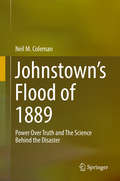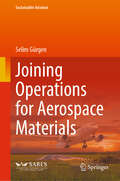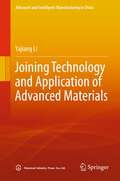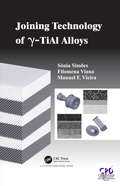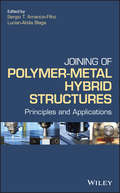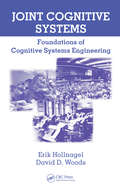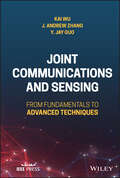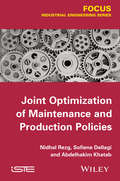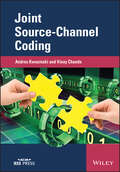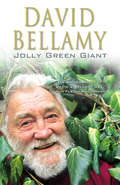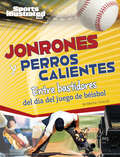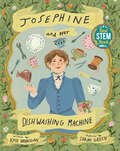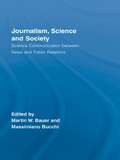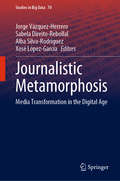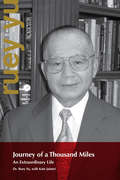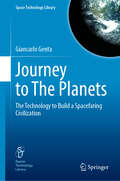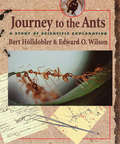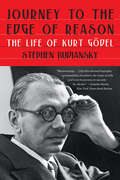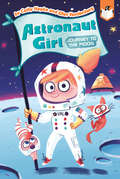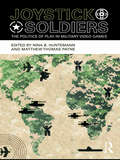- Table View
- List View
Johnstown’s Flood of 1889: Power Over Truth and The Science Behind the Disaster
by Neil M. ColemanScience now reveals the true cause of the dam breach flood that destroyed Johnstown in 1889. The tragic loss of more than 2200 lives was preventable; the initial investigation of the flood was hijacked, delayed, and distorted by powerful members of the industrial elite. This book bridges the gap between history and science, reexamining eyewitness accounts of the flood and historic documents about the investigation, and applying new LiDAR, GPS, and hydraulic studies to solve the mystery – what caused the Great Flood of 1889? The book includes a notable chapter on the “sister” of the South Fork Dam, “The Forgotten Dam” at Hollidaysburg, PA.
Joining Operations for Aerospace Materials (Sustainable Aviation)
by Selim GürgenThis book provides a deep knowledge of the specialized world of aerospace material joining, focusing on the methods, techniques, and strategies essential for creating resilient and high-performance structures in aeronautics and space applications. It uncovers the latest advancements and emerging technologies that define the future of aerospace manufacturing. From the precision demands of metallurgical joining methods to the innovative realm of mechanical joining techniques, this book provides a roadmap to mastering the intricacies of joining processes tailored for aerospace materials. Joining Operations for Aerospace Materials equips engineers, researchers, and technical staff with the expertise to navigate the challenges of working with cutting-edge materials in the most demanding environments.
Joining Technology and Application of Advanced Materials (Advanced and Intelligent Manufacturing in China)
by Yajiang LiThe book focuses on joining of advanced materials such as ceramics, intermetallics, laminated materials, composite materials and functional materials considering both in theory and in practice. It also covers details of joint design, weldability and quality assurance of the product. Both principles and engineering practice have been addressed to show advanced, scientific and novelty features. The latest research on advanced joining technology is one of the major features of the book, which is particularly suited for readers who are interested to learn practical solutions in joining of advanced materials. The book can benefit researchers, engineers and graduate students in the fields of joining, materials design and manufacturing, etc.
Joining Technology of gamma-TiAl Alloys
by Sonia Luisa Simoes Filomena Maria Viana Manuel Fernando VieiraThe book covers the development of new technologies for the joining of TiAl alloys that result in sound bonds obtained in less demanding conditions. It discusses joint processing, microstructural and mechanical characterization, and summarizes developments in new approaches to the joining of TiAl alloys using advanced characterization techniques.
Joining of Polymer-Metal Hybrid Structures: Principles and Applications
by Sergio T. Amancio-Filho Lucian-Attila BlagaA comprehensive introduction to the concepts of joining technologies for hybrid structures This book introduces the concepts of joining technology for polymer-metal hybrid structures by addressing current and new joining methods. This is achieved by using a balanced approach focusing on the scientific features (structural, physical, chemical, and metallurgical/polymer science phenomena) and engineering properties (mechanical performance, design, applications, etc.) of the currently available and new joining processes. It covers such topics as mechanical fastening, adhesive bonding, advanced joining methods, and statistical analysis in joining technology. Joining of Polymer-Metal Hybrid Structures: Principles and Applications is structured by joining principles, in adhesion-based, mechanical fastened, and direct-assembly methods. The book discusses such recent technologies as friction riveting, friction spot joining and ultrasonic joining. This is used for applications where the original base material characteristics must remain unchanged. Additional sections cover the main principles of statistical analysis in joining technology (illustrated with examples from the field of polymer-metal joining). Joining methods discussed include mechanical fastening (bolting, screwing, riveting, hinges, and fits of polymers and composites), adhesive bonding, and other advanced joining methods (friction staking, laser welding, induction welding, etc.). Provides a combined engineering and scientific approach used to describe principles, properties, and applications of polymer-metal hybrid joints Describes the current developments in design of experiments and statistical analysis in joining technology with emphasis on joining of polymer-metal hybrid structures Covers recent innovations in joining technology of polymer-metal hybrid joints including friction riveting, friction spot joining, friction staking, and ultrasonic joining Principles illustrated by pictures, 3D-schemes, charts, and drawings using examples from the field of polymer-metal joining Joining of Polymer-Metal Hybrid Structures: Principles and Applications will appeal to chemical, polymer, materials, metallurgical, composites, mechanical, process, product, and welding engineers, scientists and students, technicians, and joining process professionals.
Joint Cognitive Systems: Foundations of Cognitive Systems Engineering
by Erik Hollnagel David D. WoodsNothing has been more prolific over the past century than human/machine interaction. Automobiles, telephones, computers, manufacturing machines, robots, office equipment, machines large and small; all affect the very essence of our daily lives. However, this interaction has not always been efficient or easy and has at times turned fairly hazardous.
Joint Cognitive Systems: Patterns in Cognitive Systems Engineering
by Erik Hollnagel David D. WoodsOur fascination with new technologies is based on the assumption that more powerful automation will overcome human limitations and make our systems 'faster, better, cheaper,' resulting in simple, easy tasks for people. But how does new technology and more powerful automation change our work? Research in Cognitive Systems Engineering (CSE) l
Joint Communications and Sensing: From Fundamentals to Advanced Techniques
by Yingjie Jay Guo J. Andrew Zhang Kai WuJOINT COMMUNICATIONS AND SENSING Authoritative resource systematically introducing JCAS technologies and providing valuable information and knowledge to researchers and engineers Based on over six years of dedicated research on joint communications and sensing (JCAS) by the authors, their collaborators, and students, Joint Communications and Sensing is the first book to comprehensively cover the subject of JCAS, which is expected to deliver huge cost and energy savings, and therefore has become a hallmark of future 6G and next generation radar technologies. The book has three parts. Part I presents the basic JCAS concepts and applications and the basic signal processing algorithms to support JCAS. Part II covers communications-centric JCAS designs that describe how sensing can be integrated into communications networks such as 5G and 6G. Part III presents ways to integrate communications in various radar sensing technologies and platforms. Specific sample topics covered in Joint Communications and Sensing include: Three categories of JCAS systems, potential sensing applications of JCAS, signal processing fundamentals, and channel models for communications and radar Frameworks for perceptive mobile networks (PMNs), system modifications to enable PMN sensing, and PMN system issues Orthogonal time-frequency space waveform-based JCAS for IoT, including signal models, echo pre-processing, and target parameter estimation Joint Communications and Sensing provides valuable information and knowledge to researchers and engineers in the communications and radar sensing communities and industries, enabling them to upskill and prepare for JCAS technology research and development. The text is of particular interest to engineers in the wireless communications industry who are pursuing new capabilities in 6G.
Joint Optimization of Maintenance and Production Policies
by Abdelhakim Khatad Sofien Dellagi Nidhal RezgThis book presents the recent work regarding the different approaches developed in the framework of the joint optimization of intelligent maintenance and production strategies. The originality of these strategies is that they take various constraints into account, including production management, subcontracting environmental degradation, inspection and product quality.
Joint Source-Channel Coding (IEEE Press)
by Andres Kwasinski Vinay ChandeJoint Source-Channel Coding Consolidating knowledge on Joint Source-Channel Coding (JSCC), this book provides an indispensable resource on a key area of performance enhancement for communications networks Presenting in one volume the key theories, concepts and important developments in the area of Joint Source-Channel Coding (JSCC), this book provides the fundamental material needed to enhance the performance of digital and wireless communication systems and networks. It comprehensively introduces JSCC technologies for communications systems, including coding and decoding algorithms, and emerging applications of JSCC in current wireless communications. The book covers the full range of theoretical and technical areas before concluding with a section considering recent applications and emerging designs for JSCC. A methodical reference for academic and industrial researchers, development engineers, system engineers, system architects and software engineers, this book: Explains how JSCC leads to high performance in communication systems and networks Consolidates key material from multiple disparate sources Is an ideal reference for graduate-level courses on digital or wireless communications, as well as courses on information theory Targets professionals involved with digital and wireless communications and networking systems
Jolly Green Giant
by David BellamyDavid Bellamy is a natural story teller whose memoir will be packed full of funny anecdotes and observations. It is the story of how a city boy, brought up in the middle of London, went for a trip into the countryside one day, an event which was to transform his life by setting in motion the amazing love of nature which would make famous this larger-than-life character. In his infectious style he illumines on, amongst other things, the fact that his father, the manager of a branch of Boots, had to grease his hair straight - because in those days managers of Boots weren't allowed to have curly hair! Then there was the time he and his brother discovered an exploded bomb, kept in the garden shed - and then accidentally blew off the front of the house with it. He reveals his secret passion is ballet dancing - and how his mother only found out about it when she saw him on stage at the Fairfield Hall in Croydon. His career as an academic, then author, broadcaster, consultant and television personality, spans 35 years and his main passion - campaigning for the environment - have led to many adventures including his being twice imprisoned in the Third World.
Jonrones y perros calientes: Entre bastidores del día del juego de béisbol (Sports Illustrated Kids: día de juego)
by Martin Driscoll¿Crees que el béisbol de las grandes ligas comienza con el lanzamiento inicial? ¡Piensa otra vez! En este libro de Sports Illustrated Kids, irás detrás de escena de un día típico de juego en el béisbol profesional. Think big league baseball begins with the opening pitch? Think again! In this Sports Illustrated Kids book, go behind the scenes of a typical game day in professional baseball.
Joseph Lister: Father of Modern Surgery / The Great Stink (Fountas & Pinnell Classroom, Guided Reading)
by Kelly MartinsonNIMAC-sourced textbook
Josephine and Her Dishwashing Machine: Josephine Cochrane's Bright Invention Makes a Splash
by Kate HanniganCelebrate the inventor of the dishwasher in this inspiring STEM/STEAM picture book biography about Josephine Garis Cochrane, the brains behind one of the world's most-used kitchen appliances.Many Americans have a dishwasher in their kitchen. But who invented it?Meet Josephine Garis Cochrane: entrepreneur, innovator, girlboss. Washing dishes is a pain—it leaves Josephine's cups cracked, her dishes dinged, and her chowder bowls chipped. She&’d rather be picking flowers, frosting cakes, or playing piano than dealing with cracked crockery. What to do about a chore that&’s icky, destructive, and time-consuming? Josephine tackles this task the modern way: she makes a machine to do it for her! She tinkers and tests, and perseveres through fizzles and flops—until she has a government patent for her invention, and there are whirring, whizzing, bubbling dishwashers making a splash across America.This charming tale includes an author&’s note, a list of notable women inventors, a timeline of fascinating inventions, and a list of sources.
Journalism, Science and Society: Science Communication between News and Public Relations (Routledge Studies in Science, Technology and Society #Vol. 7)
by Massimiano Bucchi Martin W. BauerAnalyzing the role of journalists in science communication, this book presents a perspective on how this is going to evolve in the twenty-first century. The book takes three distinct perspectives on this interesting subject. Firstly, science journalists reflect on their ‘operating rules’ (science news values and news making routines). Secondly, a brief history of science journalism puts things into context, characterising the changing output of science writing in newspapers over time. Finally, the book invites several international journalists or communication scholars to comment on these observations thereby opening the global perspective. This unique project will interest a range of readers including science communication students, media studies scholars, professionals working in science communication and journalists.
Journalistic Metamorphosis: Media Transformation in the Digital Age (Studies in Big Data #70)
by Xosé López-García Jorge Vázquez-Herrero Sabela Direito-Rebollal Alba Silva-RodríguezThis book aims to reflect how journalism has changed in recent years through different perspectives concerning the impact of technology, the reconfiguration of the media ecosystem, the transformation of business models, production and profession, as well as the influence of digital storytelling, mobile devices and participation within the context of glocal information.Journalism innovation implies modifications in techniques, technologies, processes, languages, formats and devices intended to enhance the production and consumption of the journalistic information.This book becomes an interesting resource for researchers and professionals working in news media to identify the best practices and discover new types of information flows in a rapidly changing news media landscape.
Journey of a Thousand Miles: An Extraordinary Life (Biographies et mémoires)
by Dr. Ruey J. YuBorn into poverty in Japanese-occupied Taiwan, Ruey Yu overcame near-starvation during the Second World War. Destiny, however, had other plans for him: he was to become an award-winning biochemist, then the co-founder of what would soon become the multi-million-dollar skin care company NeoStrata. After living through the Second World War and the post-war military dictatorship of General Chiang Kai-Shek, Dr. Yu won a coveted post-graduate scholarship to study chemistry at the University of Ottawa. He subsequently took up a research position at the renowned Skin and Cancer Hospital (Temple University) in Philadelphia, where he collaborated with pre-eminent dermatologist Dr. Eugene Van Scott to develop treatments for serious skin diseases. In 1972, Dr. Yu and Dr. Van Scott discovered that fruit acids, known as AHAs, could effectively treat the disfiguring skin disease ichthyosis, changing the lives of thousands of people who suffered from this debilitating illness. Their further research into the biochemical properties of AHAs led to the discovery of the anti-wrinkle and anti-aging effects of these natural substances—a discovery that was licensed by skin care companies around the world, sparking the multibillion-dollar cosmeceutical industry.
Journey to The Planets: The Technology to Build a Spacefaring Civilization (Space Technology Library #43)
by Giancarlo GentaThis book gives an account, as little biased as possible, on human space missions beyond low Earth orbit in general, and specifically to the planets of the solar system. The importance of advanced propulsion is stressed and the mathematical methods needed to design missions based on them are described. The included computer code allows the user to assess the feasibility of the various missions using different propulsion systems and how advancements in propulsion can allow humankind to become a true spacefaring civilization. As opposite to the majority of books dealing with mission design, where the subject is usually dealt with in a highly mathematical way, here an attempt is made to avoid as much as possible the mathematical complexities and to focus on the practical aspects of the design. However, the equations needed to make numerical analysis and simulations of the missions are described and discussed. An original computer code is included in the book, and an appendix helps the reader to understand how to use it. The code is different from existing ones since its main aim is to be user friendly and to allow the user to make a preliminary design of interplanetary missions aimed to planets and their satellites, comets or asteroids.
Journey to the Ants: A Story of Scientific Exploration
by Edward O. Wilson Bert HölldoblerRichly illustrated and delightfully written, Journey to the Ants combines autobiography and scientific lore to convey the excitement and pleasure the study of ants can offer. Bert Hölldobler and E. O. Wilson interweave their personal adventures with the social lives of ants, building, from the first minute observations of childhood, a remarkable account of these abundant insects’ evolutionary achievement.
Journey to the Edge of Reason: The Life Of Kurt Gödel
by Stephen BudianskyThe first major biography of the logician and mathematician whose Incompleteness Theorems helped launch a modern scientific revolution. Nearly a hundred years after its publication, Kurt Gödel’s famous proof that every mathematical system must contain propositions that are true—yet never provable—continues to unsettle mathematics, philosophy, and computer science. Yet unlike Einstein, with whom he formed a warm and abiding friendship, Gödel has long escaped all but the most casual scrutiny of his life. Stephen Budiansky’s Journey to the Edge of Reason is the first biography to fully draw upon Gödel’s voluminous letters and writings—including a never-before-transcribed shorthand diary of his most intimate thoughts—to explore Gödel’s profound intellectual friendships, his moving relationship with his mother, his troubled yet devoted marriage, and the debilitating bouts of paranoia that ultimately took his life. It also offers an intimate portrait of the scientific and intellectual circles in prewar Vienna, a haunting account of Gödel’s and Jewish intellectuals’ flight from Austria and Germany at the start of the Second World War, and a vivid re-creation of the early days of Princeton’s Institute for Advanced Study, where Gödel and Einstein both worked. Eloquent and insightful, Journey to the Edge of Reason is a fully realized portrait of the odd, brilliant, and tormented man who has been called the greatest logician since Aristotle, and illuminates the far-reaching implications of Gödel’s revolutionary ideas for philosophy, mathematics, artificial intelligence, and man’s place in the cosmos.
Journey to the Moon #1 (Astronaut Girl #1)
by Cathy Hapka Ellen VandenbergCan Astronaut Girl save the day with a little help from science? Find out as she and her space crew make their debut in this chapter book series!Val, aka Astronaut Girl, is just your typical eight-year-old scientist. She has her own laboratory and conducts experiments with her crew--her cat and baby brother. She loves science and knows everything about outer space. That's why she's surprised to learn that her new neighbor Wallace would rather talk about a fake space show than about real missions. But when Astronaut Girl, Wallace, and the Astro crew get lost on their own lunar adventure, they must all work together to find their way back home.Exciting, easy-to-read books are the stepping stone a young reader needs to bridge the gap between being a beginner and being fluent.
Journey to the Stars: Space Exploration--Tomorrow and Beyond
by Robert JastrowRobert Jastrow discusses the past and future of space exploration, the cosmic mysteries that still await solution, and the possibility of extraterrestrials whose intelligence far outstrips our own.
Journeyman Electrician Exam Prep 2022 Version
by Experienced Trainers' TeamTHE UPDATED EDITION OF THE PERFECT STUDY GUIDE 195% SUCCESS RATE | PASS YOUR ELECTRICAL EXAM WITH THE HELP OF TEST SIMULATIONS WITH ANSWER KEYS
Joyriding in Riyadh
by Pascal MenoretWhy do young Saudis, night after night, joyride and skid cars on Riyadh's avenues? Who are these "drifters" who defy public order and private property? What drives their revolt? Based on four years of fieldwork in Riyadh, Pascal Menoret's Joyriding in Riyadh explores the social fabric of the city and connects it to Saudi Arabia's recent history. Car drifting emerged after Riyadh was planned, and oil became the main driver of the economy. For young rural migrants, it was a way to reclaim alienating and threatening urban spaces. For the Saudi state, it jeopardized its most basic operations: managing public spaces and enforcing law and order. A police crackdown soon targeted car drifting, feeding a nationwide moral panic led by religious activists who framed youth culture as a public issue. The book retraces the politicization of Riyadh youth and shows that, far from being a marginal event, car drifting is embedded in the country's social violence and economic inequality.
Joystick Soldiers: The Politics of Play in Military Video Games
by Nina B. Huntemann Matthew Thomas PayneJoystick Soldiers is the first anthology to examine the reciprocal relationship between militarism and video games. War has been an integral theme of the games industry since the invention of the first video game, Spacewar! in 1962.While war video games began as entertainment, military organizations soon saw their potential as combat simulation and recruitment tools. A profitable and popular relationship was established between the video game industry and the military, and continues today with video game franchises like America’s Army, which was developed by the U.S.Army as a public relations and recruitment tool. This collection features all new essays that explore how modern warfare has been represented in and influenced by video games. The contributors explore the history and political economy of video games and the "military-entertainment complex;" present textual analyses of military-themed video games such as Metal Gear Solid; and offer reception studies of gamers, fandom, and political activism within online gaming.
